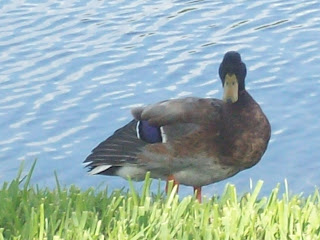Back to the subject at hand, I do have pictures of a similar hybrid/manky birds that will suit the purposes of this post well enough. Hopefully, I can make my point just as well with them.
The reason for the provocative title is because as any waterfowl biologist, birder, and aviculturists will tell you, Mallards (Anas platyrhynchos) are adulterous rapists. You heard me right. As shocking as this may seem, it is easy to write off the Mallard as a species is a diverse mishmash of colors, sizes, distributions, and origins. It's even been considered a complex much like the many circumpolar gull species that are present in the northern hemisphere, but I digress. Due to it's almost international distribution and presence on any available water body, it can live pretty much anywhere where there's food, shelter, and of course, water.
However, this presents problems for two species unique to North America, the American Black Duck (A. rubripes) and Mottled Duck (A. fulvigula). While similar in appearance the Black Duck is named for its dark body plumage, while the Mottled Duck lives up to its name by the male and female of the species possessing mottled plumage. As with the Mallard, the sexes can be separated by bill color with males possessing yellow-green bills and females sporting orange bills with brown blotches. The main problem for these birds is that they're similarly colored to female mallards and through no fault of their own often end up producing hybrid young. Whether or not this is due to being previously related to mallards in the past is to be decided in a later post (see end of this post)


As explained in the initial paragraph, I saw several "manky" birds today (to steal a phrase from here) that seemed to either be fertile hybrids or inbred with feral waterfowl. But due to a technological glitch and iPhoto system failure on my end, I don't have any of those photos any more. (I'll save the weeping for later ;_; ) However, below I've included some pictures from my Florida trip earlier this year as well as some other photos of the "Mallard complex". See if you can spot the weird ones.
Did you guess correctly? If not, you can clearly see that the fourth and fifth pictures clearly show a rufous-looking male Mallard with more extensive chestnut on his breast and belly than a normal gray-bodied male. Since I can't be sure of its origins, I can only speculate that it's more likely to be a feral cross than a wild bird cross. As for what can be done about it, that "Mallard complex" I was talking about earlier might be to blame. I'd go on to explain further, but due to the lateness at the time of writing this, I'm inclined to stop. Here however is another example of the fine complexities that Mallards display with some of the problems mentioned here.
For the final post this month, I might explore this subject a bit more by explaining my take on the "Mallard complex". I do this because of my interest in waterfowl in general, but also because I have an interest in the kind of results hybridization can have on separate species and populations. Hopefully I can explain it with better descriptions and pictures than I was able to do here. Until then, I hope you all have a lovely weekend outside in the wild blue yonder.
Update: It would appear that my computer saved the pictures of the manky mallards I wanted to post on here in the first place. Therefore, I'm going to include those pictures in this post to show what I was trying to illustrate before I supposedly lost everything. I will reiterate my point when I write more thoroughly about species complexes next week for the final posting of the month. I need to remember that this blog is for all things wildlife and associated with wildlife problems, people, and events so by focusing on a whole big taxonomic thing, I end up doing more of a service that way. Also if I want to rant about birds whenever, I'll just do so on the birding blog here. Now that that's out of the way, I'll leave you to appreciate the pictures I still had even if iPhoto seemed to crash and lose them all.
It was these three specifically show a dark bodied male Mallard but plumage details such as lack of a neck ring, overall dark body color, and lack of a defined breast color might point to a manky bird or fertile hybrid.
All I can say for sure is that while they add diversity to the field in terms of what one can see in the colors of the species, in the end, it just makes it a hell of a lot more confusing.







No comments:
Post a Comment